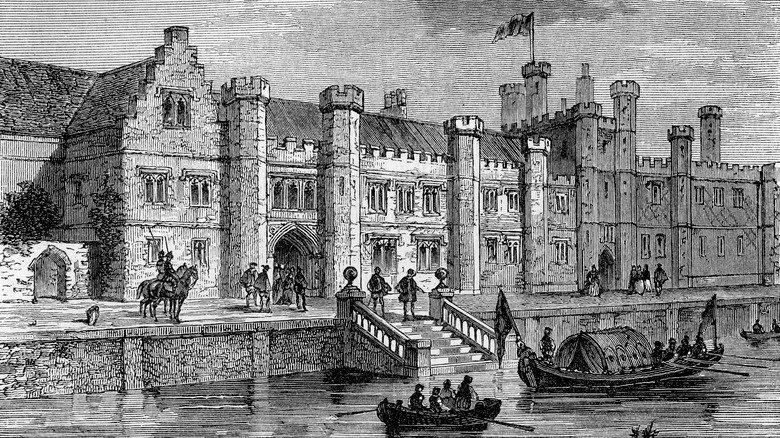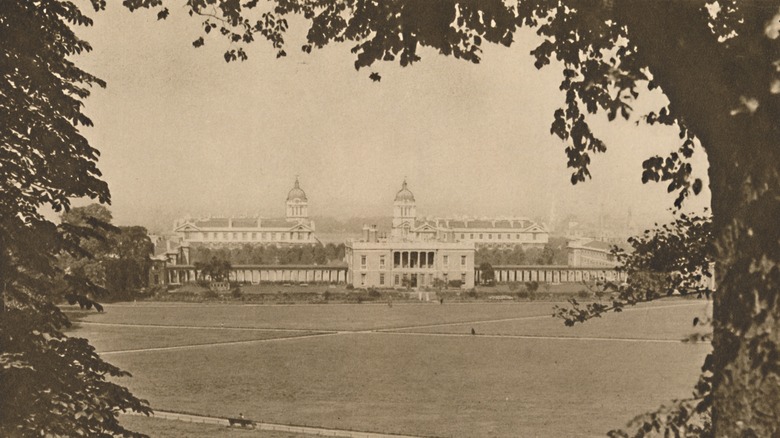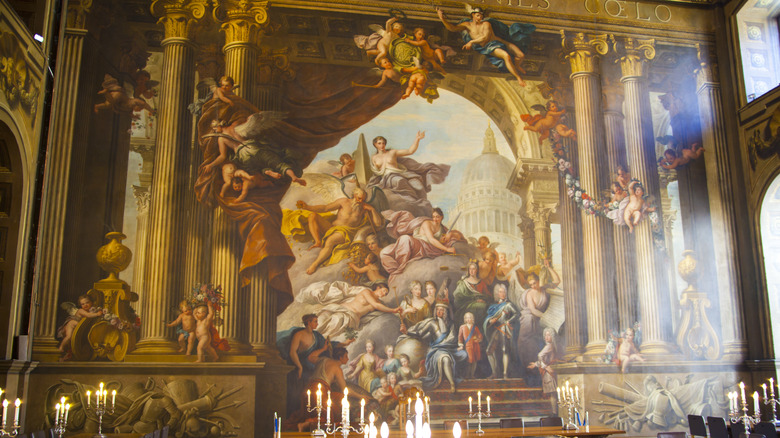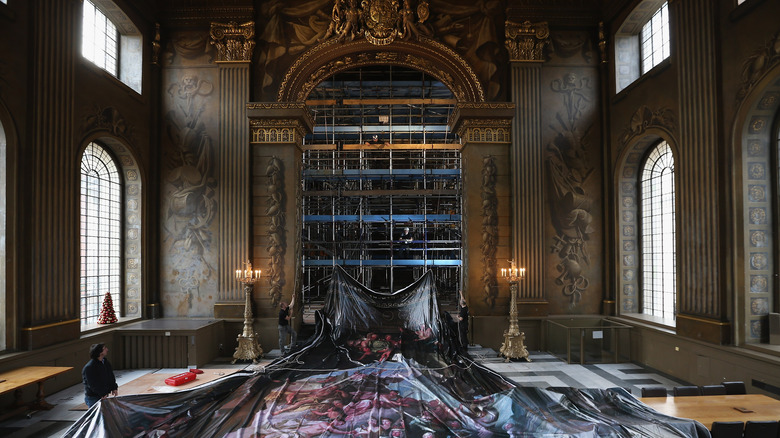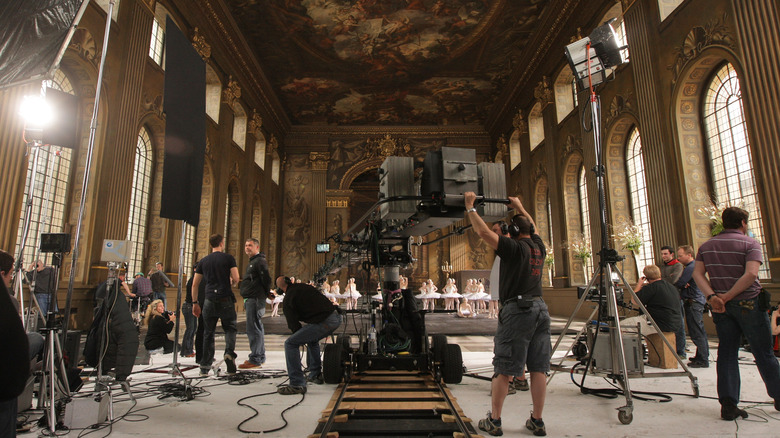Things You Didn't Know About The Palace Of Placentia
The Palace of Placentia has taken many forms. Known as Greenwich Palace from 1498 to 1694, its location later served as home to the Old Royal Naval College Greenwich (ORNC). Although the palace itself no longer exists, the place where it once sat is now a cultural heritage site that is open to the public in London.
Greenwich Palace is perhaps best known as the place where King Henry VIII was born in June 1491. It is also the birthplace of the king's daughters, Queen Mary I and Queen Elizabeth I. According to the ORNC website, the palace is considered "one of the most important Tudor residences."
During the English Civil War, which lasted from 1642 to 1651, conflicts between the Parliamentarians and the Royalists caused the palace to deteriorate. Over the course of those years, it became a biscuit (cookie) factory, and then a prisoner-of-war camp, before it was demolished altogether.
Still, echoes of the palace's history remain. Here are some things you may not know about the Palace of Placentia, then and now.
William Shakespeare was among the many entertainers who passed through the Palace of Placentia
Perhaps the most famous — or notorious — resident of the Palace of Placentia was King Henry VIII. According to the Old Royal Naval College Greenwich, the king kept two of his warships, the Great Harry and the Mary Rose, moored at docks near the palace. But the palace was also where Anne Boleyn, the second of the king's six wives, was arrested before being locked up and ultimately beheaded at the Tower of London.
King Henry VIII's daughter, Queen Elizabeth I, spent her summers at the palace, watching ships on the River Thames through the windows and listening to choral music in the palace's chapel.
Top-notch entertainment was a frequent marvel at the Palace of Placentia. In 1594, the Lord Chamberlain's Men "playing company," or acting troupe, put on a Christmas performance at the palace. The group included the iconic playwright William Shakespeare. Another notable performer was John Blanke, a black trumpet player who played at King Henry VIII's coronation. "Blanke successfully petitioned the new king for a pay rise and was even given a wedding present by Henry VIII when he married in 1512," reads the ORNC website. "But after that he disappears from the records."
The Palace's Royal Hospital for Seamen was more of a retirement home for members of the Navy
In the 1690s, the polymath Sir Christopher Wren was appointed as an architect for a new institution that would serve as a retirement home for former members of the Royal Navy. According to the Old Royal Naval College Greenwich, Wren was best known for his work as the architect of Hampton Court Palace and St. Paul's Cathedral.
The Royal Hospital for Seamen was founded by Queen Mary II and King William III. During the building's construction, Wren was busy rebuilding the city — specifically, "over 50 churches" — after the Great Fire of London. Due to Wren's busy schedule, his assistant, Nicholas Hawksmoor, ended up doing most of the work on the elaborate baroque structure of the Royal Hospital.
Despite its name, the Royal Hospital for Seamen was less of a hospital and more of a retirement home. According to the ORNC, the so-called hospital did not have the equipment or facilities to help with serious illnesses or injuries, so residents suffering with such issues were sent away to official hospitals elsewhere in the city.
The Palace of Placentia is home to 'Britain's Sistine Chapel'
The Painted Hall in the Palace of Placentia has been referred to as "Britain's Sistine Chapel." The hall was the handiwork of Sir James Thornhill, whose murals also appear at St. Paul's Cathedral. According to the Old Royal Naval College, Thornhill spent 19 years on the project from start to finish. He was paid one British pound for each yard of painting on the walls, and three pounds for each yard on the ceiling, for a total of £6,685 — which would be a fortune by today's standards.
Thornhill painted the mural at the Painted Hall in an Italian baroque style. According to the ORNC, the painting tells "an incredible story of political change, scientific and cultural achievements, naval endeavors and commercial enterprise all set against a series of magnificent backdrops."
The painting was commissioned in 1707 and completed in 1726. Due to the political changes that occurred in Great Britain throughout those two decades, Thornhill was left with the task of continuously adjusting and reconfiguring the events depicted in the mural.
In 2017, experts discovered new rooms of the original palace, which once housed... bees?
The remains of the Palace of Placentia are now buried underneath the Old Royal Naval College. In 2017, experts working on an £8.5 million restoration project discovered two rooms that were a part of the original palace.
According to the Daily Mail, both of the rooms are likely to have been used primarily by service personnel at the palace. Historians suspect that the rooms could have housed the palace's kitchens or laundry facilities. One of the rooms was found to have been situated underground and featured "a series of unusual niches." These "niches" are believed to have housed beehives for bee colonies hibernating in the winter and to have been used to keep drinks and food items cool in the summer.
"This is a really remarkable find," Chief Executive of Historic England Duncan Wilson said of the discoveries (via Daily Mail). "To find a trace of Greenwich Palace, arguably the most important of all the Tudor palaces, is hugely exciting. The unusual and enigmatic nature of the structure has given us something to scratch our heads over and research, but it does seem to shine a light on a very poorly known function of the gardens and royal bees."
Today, the Palace of Placentia is 'the world's most popular filming location'
Today, the site of the former Palace of Placentia brings in over 1.2 million visitors each year, according to the Old Royal Naval College. Along with the ORNC buildings, the site is also home to the University of Greenwich and Trinity Laban Conservatoire of Music and Dance.
The ORNC deems its site "the world's most popular filming location." The website boasts a vast list of movies that have filmed scenes at the historic site from 1925 to today.
In the 1990s, British classics such as "Four Weddings and a Funeral" and the 1995 film adaptation of "Sense & Sensibility" — starring Kate Winslet, Emma Thompson, and Hugh Grant — included scenes filmed onsite.
Some of the most notable works to have filmed at the ORNC include the "Sherlock Holmes" movies starring Robert Downey Jr., "Pirates of the Caribbean: On Stranger Tides," "The King's Speech," and episodes of Netflix's "The Crown."
In 2012 alone, the ORNC was a setting for blockbusters including "Les Miserables," "Skyfall," and "The Dark Knight Rises."
